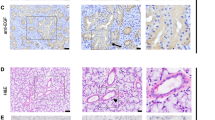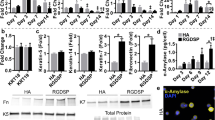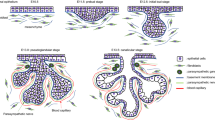Abstract
Rho GTPases participate in a wide variety of signal transduction pathways regulating the actin cytoskeleton, gene expression, cellular migration and proliferation. The aim of this study was to evaluate the role of Rho GTPases in signal transduction pathways during acinus formation in a human salivary gland (HSG) cell line initiated by extracellular matrix (ECM; Matrigel) alone or in combination with epidermal growth factor, basic fibroblast growth factor and lysophosphatidic acid (LPA). Immunohistochemical and Western blotting analyses showed that HSG cells contained RhoA, RhoB, Rac1 and Cdc42 proteins. All growth factors enhanced the effects of ECM on acinus formation, in a pathway dependent on PI3-kinase and Rho GTPases. The role of ROCK, a major RhoA effector, seemed limited to cortical actin polymerization. LPA stimulated cell migration and acinus formation in a PI3-kinase-independent pathway. The results suggest that Rho proteins are important for epithelial-mesenchymal interactions during salivary gland development.








Similar content being viewed by others
References
Amano M, Chihara K, Kimura K, Fukata Y, Nakamura N, Matsuura Y, Kaibuchi K (1997) Formation of actin stress fibers and focal adhesions enhanced by Rho-kinase. Science 275:1308–1311
Bishop AL, Hall A (2000) Rho GTPases and their effector proteins. Biochem J 348:241–255
Bokoch GM, Vlahos C, Wang Y, Knaus UG, Traynor-Kaplan AE (1996) Rac GTPase interacts specifically with phosphatidylinositol 3-kinase. Biochem J 315:775–779
Bradford MA (1976) A rapid and sensitive method for the quantitation of microgram amounts of protein utilizing the principle of protein-dye binding. Anal Biochem 72:248–254
Burridge K, Wennerberg K (2004) Rho and Rac take center stage. Cell 116:167–179
Etienne-Manneville S, Hall A (2002) Rho GTPases in cell biology. Nature 420:629–635
Genot EM, Arrieumerlou C, Ku G, Burgering BMT, Weiss A, Kramer IM (2000) The T-cell receptor regulates Akt (protein kinase B) via a pathway involving Rac1 and phosphatidylinositide 3-kinase. Mol Cell Biol 20:5469–5478
Hall A, Nobes CD (2000) Rho GTPases: molecular switches that control the organization and dynamics of the actin cytoskeleton. Philos Trans R Soc Lond B Biol Sci 355:965–970
Hawkins PT, Eguinoa A, Qiu RG, Stokoe D, Cooke FT, Walters R, Wennstrom S, Claesson-Welsh L, Evans T, Symons M, et al (1995) PDGF stimulates an increase in GTP-Rac via activation of phosphoinositide 3-kinase. Curr Biol 5:393–403
Hiramatsu Y, Kagami H, Horie K, Okazaki Y, Shigetomi T, Hata K, Kobayashi S, Ueda M (2000) Effects of basic fibroblast growth factor on cultured rat and human submandibular salivary gland cells. Arch Oral Biol 45:593–599
Hoffman MP, Kibbey MC, Letterio JJ, Kleinman HK (1996) Role of laminin-1 and TGF-β3 in acinar differentiation of a human submandibular gland cell line (HSG). J Cell Sci 109:2013–2021
Hoffman MP, Nomizu M, Roque E, Lee S, Jung DW, Yamada Y, Kleinman HK (1998) Laminin-1 and laminin-2 G-domain synthetic peptides bind syndecan-1 and are involved in acinar formation of a human submandibular gland cell line. J Biol Chem 273:28633–28641
Just I, Wilm M, Selzer J, Rex G, Eichel-Streiber C von, Mann M, Aktories K (1995) The enterotoxin from Clostridium difficile (Tox A) monoglucosylates the Rho proteins. J Biol Chem 270:13932–13936
Kleinman HK, Martin GR (2005) Matrigel: basement membrane matrix with biological activity. Semin Cancer Biol 15:378–386
Koyama N, Kashimata M, Sakashita H, Sakagami H, Gresik EW (2003) EGF-stimulated signaling by means of PI3K, PLCγ1, and PKC isozymes regulates branching morphogenesis of the fetal mouse submandibular gland. Dev Dyn 227:216–226
Larsen M, Hoffman MP, Sakai T, Neibaur JC, Mitchell JM, Yamada KM (2003) Role of PI 3-kinase and PIP3 in submandibular gland branching morphogenesis. Dev Biol 255:178–191
Menko AS, Kreidberg JA, Ryan TT, Van Bockstaele E, Kukuruzinska MA (2001) Loss of alpha3beta1 integrin function results in an altered differentiation program in the mouse submandibular gland. Dev Dyn 220:337–349
Menko AS, Zhang L, Schiano F, Kreidberg JA, Kukuruzinska MA (2002) Regulation of cadherin junctions during mouse submandibular gland development. Dev Dyn 224:321–333
Nobes CD, Hall A (1999) Rho GTPases control polarity, protrusion, and adhesion during cell movement. J Cell Biol 144:1235–1244
Radeff-Huang J, Seasholtz TM, Matteo RG, Brown JH (2004) G protein mediated signaling pathways in lysophospholipid induced cell proliferation and survival. J Cell Biochem 92:949–966
Raftopoulou M, Hall A (2004) Cell migration: Rho GTPases lead the way. Dev Biol 265:23–32
Ridley AJ (2001a) Rho GTPases and cell migration. J Cell Sci 114:2713–2722
Ridley AJ (2001b) Rho proteins, PI 3-kinase, and monocyte/macrophage motility. FEBS Lett 498:168–171
Ridley AJ, Hall A (1992) The small GTP-binding protein Rho regulates the assembly of focal adhesions and actin stress fibers in response to growth factors. Cell 70:389–399
Ridley AJ, Paterson HF, Johnston CL, Diekmann D, Hall A (1992) The small GTP-binding protein Rac regulates growth factor-induced membrane ruffling. Cell 70:401–410
Royce LS, Kibbey MC, Mertz P, Kleinman HK, Baum BJ (1993) Human neoplastic submandibular intercalated duct cells express an acinar phenotype when cultured on a basement membrane matrix. Differentiation 52:247–255
Santos MF, McCormack SA, Guo Z, Okolicany J, Johnson LR, Tigyi G (1997) Rho proteins play a critical role in cell migration during the early phase of mucosal restitution. J Clin Invest 100:216–225
Sato N, Kyakumoto S, Sawano K, Ota M (1996) Proliferative signal transduction by epidermal growth factor (EGF) in the human salivary gland adenocarcinoma (HSG) cell line. Biochem Mol Biol Int 38:597–606
Schmitz AAP, Govek E, Bottner B, Van Aelst L (2000) Rho GTPases: signaling, migration, and invasion. Exp Cell Res 261:1–12
Schwartz-Arad D, Arber L, Arber N, Zajicek G, Michaeli Y (1988) The rat parotid gland—a renewing cell population. J Anat 161:143–151
Shirasuna K, Sato M, Miyazaki T (1981) A neoplastic epithelial duct cell line established from an irradiated human salivary gland. Cancer 48:745–752
Steinberg Z, Myers C, Heim VM, Lathrop CA, Rebustini IT, Stewart JS, Larsen M, Hoffman MP (2005) FGFR2b signaling regulates ex vivo submandibular gland epithelial cell proliferation and branching morphogenesis. Development 132:1223–1234
Takai Y, Sasaki T, Matozaki T (2001) Small GTP-binding proteins. Physiol Rev 81:153–208
Vukicevic S, Kleinman HK, Luyten FP, Roberts AB, Roche NS, Reddi AH (1992) Identification of multiple active growth factors in basement membrane Matrigel suggests caution in interpretation of cellular activity related to extracellular matrix components. Exp Cell Res 202:1–8
Zheng C, Hoffman MP, McMillan T, Kleinman HK, O’Connell BC (1998) Growth factor regulation of the amylase promoter in a differentiating salivary acinar cell line. J Cell Physiol 177:628–635
Acknowledgements
We thank Marley Januário da Silva and Leandro Mantovani de Castro for excellent technical assistance.
Author information
Authors and Affiliations
Corresponding author
Additional information
This work was supported by FAPESP (grant numbers: 97/09507-6, 01/09047-2).
Rights and permissions
About this article
Cite this article
Crema, V.O., Hamassaki, D.E. & Santos, M.F. Small Rho GTPases are important for acinus formation in a human salivary gland cell line. Cell Tissue Res 325, 493–500 (2006). https://doi.org/10.1007/s00441-006-0192-6
Received:
Accepted:
Published:
Issue Date:
DOI: https://doi.org/10.1007/s00441-006-0192-6




